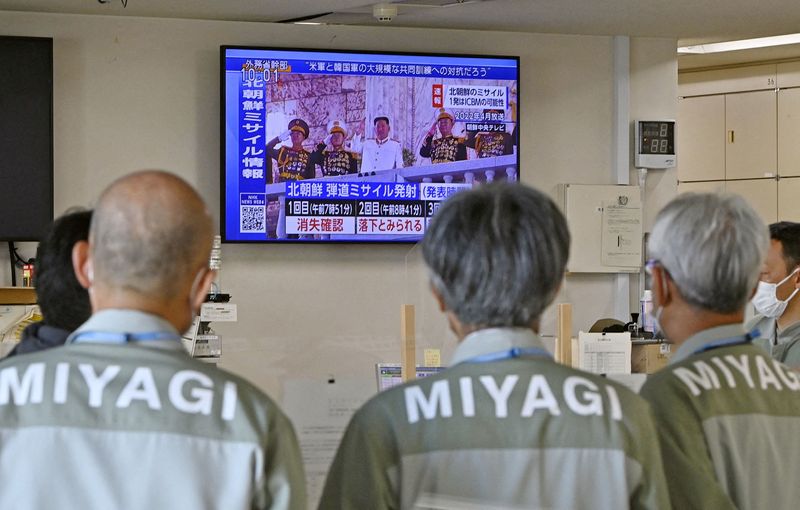Flurry of North Korean launches demonstrates complexity of missile defences
2022.11.04 02:33
[ad_1]

© Reuters. FILE PHOTO: Miyagi Prefectural Government officials watch a TV news about North Korea’s firing of ballistic missiles at the office in Sendai, Miyagi Prefecture, Japan in this photo taken by Kyodo on November 3, 2022. Mandatory credit Kyodo/via REUTERS/F
By Josh Smith
SEOUL (Reuters) – North Korea’s barrage of missiles this week was a vivid illustration of how tracking and intercepting waves of missiles at different altitudes and trajectories is a complex task – even in peacetime.
The challenge was evident in conflicting and sometime contradictory details released by South Korea and Japan about the launches. Early Thursday, the Japanese government said a North Korean missile had flown over its territory, but hours later said it had not.
A former senior U.S. defence official who served in Korea cautioned that the confusion was not a reflection on missile defence capabilities.
“What is happening is both Korea and Japan want to get as much information out as soon as possible, oftentimes sacrificing accuracy for speed in reporting an event,” he told Reuters on condition of anonymity to discuss sensitive matters.
There is a difference between providing the public with a rundown of a missile’s flight, and real-time data the military uses for missile defence, the former official said.
“Full analysis requires a little time to compute, recheck and analyse,” he said. “That is not what happens in our air and missile defence operations centres.”
South Korea and Japan also don’t have the “highly reliable and desirable” space-based infrared sensors available to the United States that promptly detect missile stages as they ignite, said Ankit Panda, a missile expert at the Carnegie Endowment for International Peace.
“The U.S. will always have a better view of these events than Seoul or Tokyo, who rely on a range of surface and sea-based sensors to track missiles,” he said of missile tests.
The sheer number of missiles tested this week highlights North Korea’s efforts to mass produce small but manoeuvrable weapons aimed at evading and overwhelming defences, he added.
“In a conflict, North Korea would be simultaneously salvo launching multiple ballistic missiles; Seoul and Tokyo may be able to employ missile defence systems successfully against a few incoming targets to limit damage, but overall, missile defence will still be a tall task,” Panda said.
COMBINED SYSTEMS
For a variety of reasons, including a desire for autonomy and promoting indigenous weapons, as well as tense ties with Japan and worries over angering China, South Korea has resisted integrating its missile defence system with that of the United States as tightly as Japan has, analysts say.
The former U.S. defence official said South Korean and U.S. systems are still closely combined, however. The United States, South Korea and Japan participated in a ballistic missile defence exercise off Hawaii’s coast in August – the first since 2017.
The three countries conducted another such exercise in early October after North Korea launched a ballistic missile that flew over Japan.
Many of North Korea’s most recent short-range ballistic missiles (SRBMs), such as its KN-23, KN-24, and KN-25, are designed to complicate efforts to detect and intercept them.
North Korea also claims to be developing a new type of “hypersonic missile”, which relies on high speed as well as manoeuvrability to avoid interception.
After North Korea tested a hypersonic missile in January, South Korean President Yoon Suk-yeol – then still a candidate – said there would be no time to shoot down such a weapon, leaving “no recourse but a preemptive strike.”
As president he has ordered the expansion of Air Defence Missile Command to boost the country’s multilayered air-defence system, while also pouring resources into weapons aimed at destroying missiles before they can be launched.
A growing number of voices in South Korea have called for the country to develop nuclear warheads, or for the United States to re-deploy tactical nuclear weapons to the peninsula.
Yoon’s government has said it has no such plans.
[ad_2]
Source link








